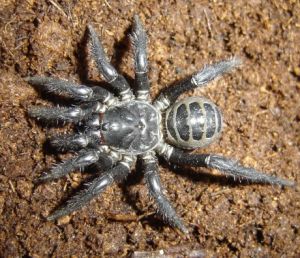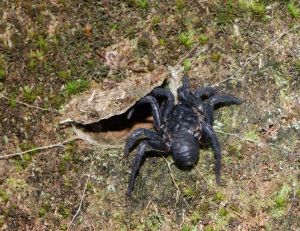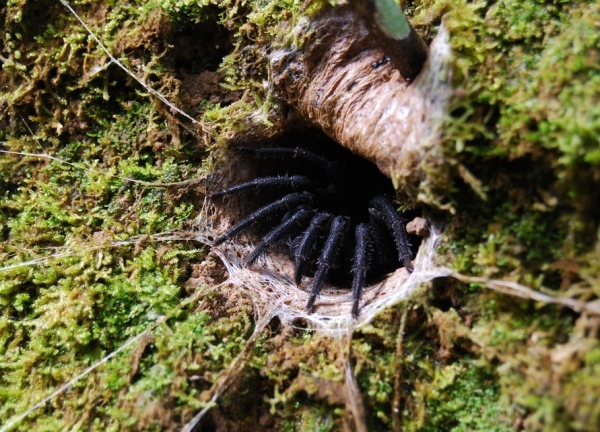Rainier Feolix
If we're fortunate enough eventually to write a second edition of Spider Silk, we'll have to make a change: contrary to what we wrote, we now know that mesothele spiders do have venom glands.
 Mesotheles are the oldest branch of the spider evolutionary tree. Arachnologists consider them "living fossils": these spiders remain outwardly virtually identical to a 290-million-year-old mesothele fossil found in France, so their characteristics and behaviors can provide insight about spiders' early evolutionary history. They share a common ancestor with the much more numerous mygalomorphs (tarantulas and their closest relatives) and araneomorphs (the "true spiders" most of us are more likely to come into contact with), which in turn share a more recent common ancestor that they don't share with the mesotheles. Mesotheles are difficult to study. They live only in Asia, they're hard to find, and they're long-lived, which means any researcher wanting to study their life cycle has to be awfully patient.
Mesotheles are the oldest branch of the spider evolutionary tree. Arachnologists consider them "living fossils": these spiders remain outwardly virtually identical to a 290-million-year-old mesothele fossil found in France, so their characteristics and behaviors can provide insight about spiders' early evolutionary history. They share a common ancestor with the much more numerous mygalomorphs (tarantulas and their closest relatives) and araneomorphs (the "true spiders" most of us are more likely to come into contact with), which in turn share a more recent common ancestor that they don't share with the mesotheles. Mesotheles are difficult to study. They live only in Asia, they're hard to find, and they're long-lived, which means any researcher wanting to study their life cycle has to be awfully patient.
With the exception of the araneomorph family Uloboridae, (which clearly lost them during evolution) all other spiders have venom glands. So whether or not mesotheles also have them is an important spider evolution question, especially as researchers work to figure out how spiders first evolved along a different path from their closest arachnid relatives. Depending on the answer, researchers would look for the origins of the venom glands in one of two different time spans. If the mesotheles don't have venom glands, it probably means that this characteristic evolved after the original mesotheles but before the mygalomorph and araneomorph lineages diverged, between about 300 million years ago and 250 million years ago. But if all three major branches of the spider evolutionary tree (mesotheles, mygalomorphs, and araneomorphs) have venom glands, it means that the common ancestor of all the spiders probably also had venom glands.  This common ancestor lived in its burrow at least 300 million years ago, and perhaps even more than 350 million years ago. (A third possibility, that the common ancestor of all spiders had venom glands but the mesotheles lost theirs during evolution, has usually been considered much less likely than these other two possibilities.)
This common ancestor lived in its burrow at least 300 million years ago, and perhaps even more than 350 million years ago. (A third possibility, that the common ancestor of all spiders had venom glands but the mesotheles lost theirs during evolution, has usually been considered much less likely than these other two possibilities.)
The best single source of information on mesotheles is Joachim Haupt's 2003 monograph. In his studies, Haupt couldn't find either venom glands or the duct openings in the fangs that would indicate the presence of glands.
But now Rainer Foelix (author of the standard text Biology of Spiders) and Bruno Erb report in the latest issue of the Journal of Arachnology that they have indeed found such openings in nine different mesothele species by using stronger magnification. It wasn't easy. The openings measure only 5 to 10 micrometers in diameter (about the same size as a single red blood cell), and they lie not at the tip of the fang, where they would be easier to locate, but along its length. Having found the opening, Foelix and Erb were pretty sure they would find the gland, but this also proved challenging. Their description of how they had to tease out individual muscle fibers with watchmaker's forceps in order to expose the gland makes performing root canal look easy.






